Farming
Miss Chicken of Tomorrow
Two "Chicken of Tomorrow" contests were held. The first in 1948, and the second in 1951. Their purpose was to encourage farmers to breed meatier chickens. And they apparently succeeded. Modern Farmer magazine reports that, "Some of the champions of these competitions became the major genetics suppliers of today's poultry."Of course, at the time one couldn't hold such a major competition without simultaneously holding a beauty contest to find a young woman to be its queen. So, Nancy Magee became the first "Chicken of Tomorrow Queen" and Joan Walters was the second. Joan got quite a bit more publicity. She was paraded around the country as "Miss Chicken of Tomorrow."
For more info, check out this old documentary on YouTube about the 1948 contest.

Nancy Magee, the 1948 Chicken of Tomorrow Queen

"Miss Joan Walters of Rogers, Ark., 18-year-old brunette beauty, was crowned Chicken-of-Tomorrow Queen here last Friday night in a ceremony at the University of Arkansas field house."--The Madison County Record - Apr 12, 1951

"Miss Joan Walters of Rogers, Ark., was recently named National Chicken-of-Tomorrow Queen." Image source: Arkansas Land and Life - Spring/Summer 2004

San Bernardino County Sun - Apr 8, 1951

Orlando Evening Star - May 25, 1951
Posted By: Alex - Tue Nov 02, 2021 -
Comments (0)
Category: Awards, Prizes, Competitions and Contests, Farming, 1940s, 1950s
The Farm Art of Jens ‘Art’ Morrison
Jens 'Art' Morrison, of Cedar Rapids, Iowa, was a practitioner of 'farm art'. Or, as he put it, he was a 'farmicist'. He mostly worked in ceramics and was most active during the 1970s and '80s.By 'farm art' he meant that a) farm animals were a recurring theme throughout his work, and b) there was a heavy emphasis on quirky, folk humor in his work, as well as A LOT of bad puns (see 'farmicist'). So, 'farm art' was deliberately distinct from 'serious art'.
One of his creations was 'Juxtapachickens.' This was a series of fourteen-inch ceramic chickens. (The url juxtapachicken.com leads to a site that consists solely of a picture of two skinned chickens in a pot. I have no idea if this was somehow inspired by or related to Morrison's work. I'm guessing not.)
Far more elaborate was his "artillogical" discovery of the "Farmounians," who he claimed were the ancient, original settlers of Iowa. As he put it:

He created (or 'discovered') numerous artifacts of these Farmounians, such as 'corntainers' that displayed ancient-looking ceramic reliefs he called 'Pigtaglyphs'. He said he was just providing 'infarmation' about this ancient culture.

Morrison even wrote a book about the Farmounians — A History of Farmounia. He described it as a 'Historical Gehography'. It's an obscure work, but there's a copy available on abebooks for $33.66 (plus $34 shipping from the UK to US).

Posted By: Alex - Tue Oct 12, 2021 -
Comments (2)
Category: Animals, Farming, Art
Portable Pig Launchers
In the pipe industry (that is, pipes through which things flow, not the pipes one smokes), 'pigs' are defined as inspection gauges that travel through pipes (see wikipedia).This leads to some odd product names, such as Portable Pig Launchers, Bi-Directional Pigs, and Subsea Pig Trackers.
iNPIPE Products offers a full line of portable pig launchers.

Posted By: Alex - Fri Oct 01, 2021 -
Comments (7)
Category: Odd Names, Farming
Teacher fired for in-class castration
June 1992: Dick W. Pirkey Jr., a teacher at Harmony High School in Texas, was fired from his job after a student in his animal husbandry class castrated a pig with his mouth. Pirkey acknowledged that he had described such a procedure to his students, but insisted that the 17-year-old had performed the procedure without his permission and before he could stop it.Seven months elapsed between the incident and Pirkey's termination. Explaining the delay, the School Superintendent admitted that when the board had first heard about the in-class oral castration they had thought it was a joke and that someone was trying to play a trick on them.
Pirkey appealed his termination, noting that oral castration was described in a state-approved textbook, and that it was also "routinely practiced throughout the state, but not in our locale, and is normally performed on sheep."
However, his firing was ultimately upheld by the State Commissioner of Education who pointed out that instead of stepping in to stop the student from performing the procedure, Pirkey had actually taken pictures of him as he did it. In fact, Pirkey even took a picture of the student "holding the testicle overhead in a victory stance."

Tyler Morning Telegraph - June 20, 1992

Longview News Journal - Feb 26, 1994
Posted By: Alex - Tue Sep 15, 2020 -
Comments (3)
Category: Animals, Farming, Education, 1990s
Johnnie the Tractor-Driving Monkey
The 1977 video below features both Johnnie and his son, Johnnie II. But mostly Johnnie II.The owner of both, Australian farmer Lindsay Schmidt, said of the original Johnnie:
We take it in turns to drive and toss off the hay to the sheep and cattle."

Billings Gazette - Jan 17, 1965
Posted By: Alex - Fri Jul 24, 2020 -
Comments (1)
Category: Animals, Farming, Motor Vehicles
Squatter, the Sheep-Raising Game
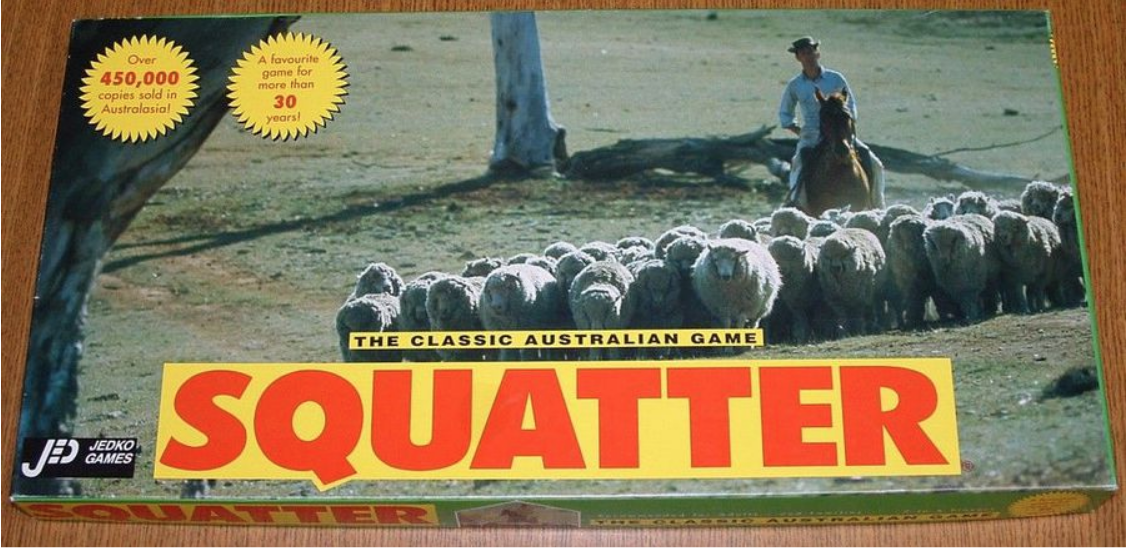
Entry at games database, with pix.
Wikipedia page.
"Some board games turn up the tension so high you practically sweat through your clothes. Squatter, an Australian import which brings home the high-stakes world of sheep-herding, is probably not one of them."
Posted By: Paul - Tue Jul 07, 2020 -
Comments (0)
Category: Animals, Farming, Games, Australia
Elm Farm Ollie Day
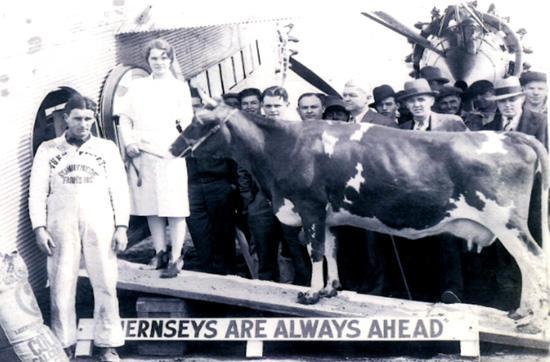
Feb. 18 is Elm Farm Ollie Day, commemorating the first flight in a plane by a cow. An article posted over at rootsweb.ancestry.com tells us that Elm Farm Ollie (aka Sunnymede Ollie, Nellie Jay, or Sky Queen) is remembered each year at the dairy festival in Mount Horeb, Wisconsin:
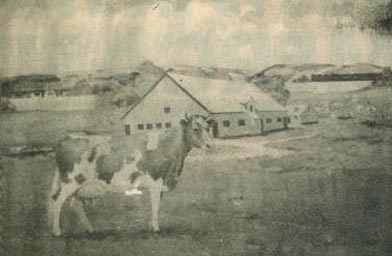
A 1930 news-wire story provided details about the historic flight:
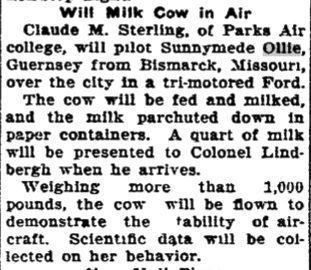
Claude M. Sterling, of Parks Air college, will pilot Sunnymede Ollie, Guernsey from Bismarck, Missouri, over the city in a tri-motored Ford.
The cow will be fed and milked and the milk parachuted down in paper containers. A quart of milk will be presented to Colonel Lindbergh when he arrives.
Weighing more than 1000 pounds, the cow will be flown to demonstrate the ability of aircraft. Scientific data will be collected on her behavior.
-The Evening Tribune (Albert Lea, Minn.) - Feb. 18, 1930.
More info at wikipedia and mustardmuseum.com.
Posted By: Alex - Tue Feb 18, 2020 -
Comments (7)
Category: Animals, Farming, Air Travel and Airlines, 1930s
Weirdo the Cat-Killing Superchicken
Weirdo was a giant among chickens. He weighed a colossal twenty-three pounds — about four times the size of an average rooster. Throughout much of the 1970s and 80s, he was listed in the Guinness Book of Records as the heaviest chicken in the world. He was said to have the strength and stamina of an ostrich.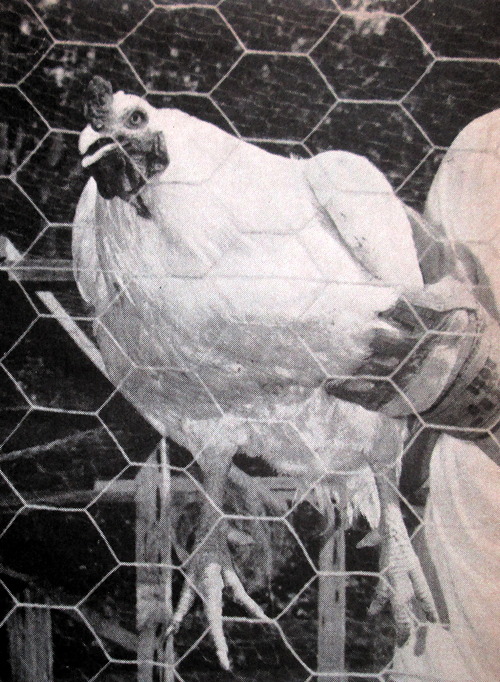
However, Weirdo had a temper and ferocity that matched his size. His violent exploits were legendary. He killed two cats and pecked out the eye of a dog. He routinely tore bits of metal off his feed bucket, demolishing feeders at a rate of one per month. When an ungloved visitor made the mistake of trying to touch him, he removed their fingertip. He shattered the lens of a camera. And, in his crowning achievement, he managed to rip through a wire fence and attacked and killed one of his own sons, an eighteen-pound rooster.
Just as unusual as Weirdo himself was the story of how he came to exist. He was the result of a seven-year chicken-breeding program conducted by a teenage boy, Grant Sullens, of West Point, California. Sullens had decided that he wanted to create a breed of "superchickens," and he actually achieved his goal, succeeding where highly paid poultry researchers had failed.
More in extended >>
Posted By: Alex - Mon Nov 18, 2019 -
Comments (4)
Category: Animals, Farming, 1970s
Bossy the Electrified Cow
In the future, when robot cows rule the world, they'll look back on Bossy as one of the first of their kind.
Sumter County Journal - Apr 17, 1941
Posted By: Alex - Tue Oct 29, 2019 -
Comments (2)
Category: Robots, Technology, AI, Robots and Other Automatons, Farming, Cows, 1940s
Champion Chicken Picker Ernest Hausen
Ernie Hausen, of Fort Atkinson, Wisconsin, had one great talent. He could pick the feathers off of chickens really, really fast.When he started picking chickens, in 1904, it took him a full half hour to defeather one. Since he was paid 5 cents per chicken, he wasn't making much money. Over the years he sped up. By 1922, he won a Chicken Picking Championship by picking his chicken clean in 6 seconds. He topped this in 1939, upping his time to 3.5 seconds. As far as I know, that record stands to this day.
His technique:
-Ithaca Journal - Feb 7, 1946
More info: Hoard Museum

Wisconsin State Journal - Jan 2, 1946
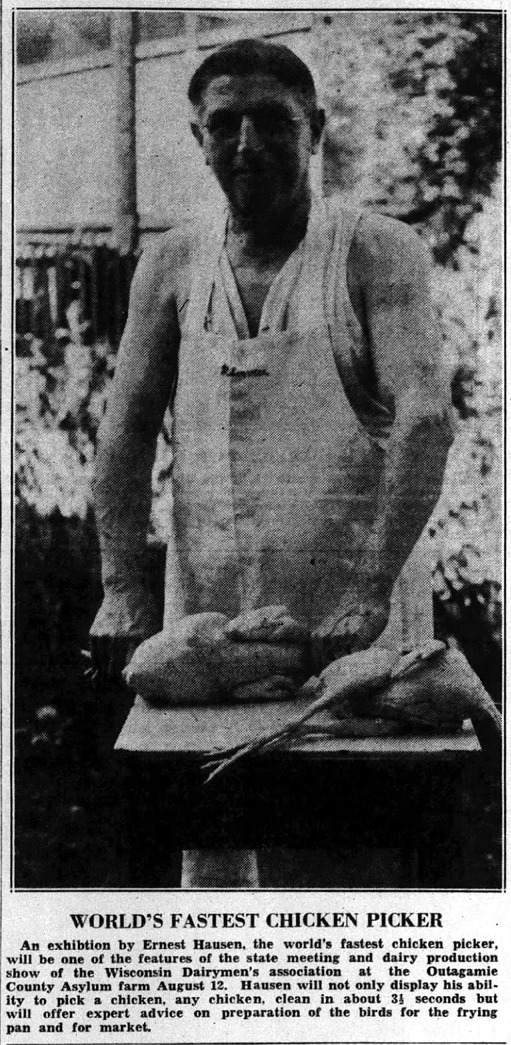
Appleton Post-Crescent - Jul 28, 1936

McAllen Monitor - Oct 28, 1946

Posted By: Alex - Fri Sep 27, 2019 -
Comments (1)
Category: Animals, Farming, Human Marvels, World Records

| Who We Are |
|---|
| Alex Boese Alex is the creator and curator of the Museum of Hoaxes. He's also the author of various weird, non-fiction, science-themed books such as Elephants on Acid and Psychedelic Apes. Paul Di Filippo Paul has been paid to put weird ideas into fictional form for over thirty years, in his career as a noted science fiction writer. He has recently begun blogging on many curious topics with three fellow writers at The Inferior 4+1. Contact Us |




